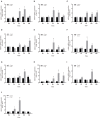A Possible Role of Crustacean Cardioactive Peptide in Regulating Immune Response in Hepatopancreas of Mud Crab
- PMID: 32425935
- PMCID: PMC7204942
- DOI: 10.3389/fimmu.2020.00711
A Possible Role of Crustacean Cardioactive Peptide in Regulating Immune Response in Hepatopancreas of Mud Crab
Abstract
Crustacean cardioactive peptide (CCAP), a cyclic amidated non-apeptide, is widely found in arthropods. The functions of CCAP have been revealed to include regulation of heart rate, intestinal peristalsis, molting, and osmotic pressure. However, to date, there has not been any report on the possible involvement of CCAP in immunoregulation in crustaceans. In this study, a CCAP precursor (designated as Sp-CCAP) was identified in the commercially important mud crab Scylla paramamosain, which could be processed into four CCAP-associated peptides and one mature peptide (PFCNAFTGC-NH2). Bioinformatics analysis indicated that Sp-CCAP was highly conserved in crustaceans. RT-PCR results revealed that Sp-CCAP was expressed in nerve tissues and gonads, whereas the Sp-CCAP receptor gene (Sp-CCAPR) was expressed in 12 tissues of S. paramamosain, including hepatopancreas. In situ hybridization further showed that an Sp-CCAPR-positive signal is mainly localized in the F-cells of hepatopancreas. Moreover, the mRNA expression level of Sp-CCAPR in the hepatopancreas was significantly up-regulated after lipopolysaccharide (LPS) or polyriboinosinic polyribocytidylic acid [Poly (I:C)] challenge. Meanwhile, the mRNA expression level of Sp-CCAPR, nuclear transcription factor NF-κB homologs (Sp-Dorsal and Sp-Relish), member of mitogen-activated protein kinase (MAPK) signaling pathway (Sp-P38), pro-inflammatory cytokines factor (Sp-TNFSF and Sp-IL16), and antimicrobial peptide (Sp-Lysozyme, Sp-ALF, Sp-ALF4, and Sp-ALF5) in the hepatopancreas were all up-regulated after the administration of synthetic Sp-CCAP mature peptide both in vivo and in vitro. The addition of synthetic Sp-CCAP mature peptide in vitro also led to an increase in nitric oxide (NO) concentration and an improved bacterial clearance ability in the hepatopancreas culture medium. The present study suggested that Sp-CCAP signaling system might be involved in the immune responses of S. paramamosain by activating immune molecules on the hepatopancreas. Collectively, our findings shed new light on neuroendocrine-immune regulatory system in arthropods and could potentially provide a new strategy for disease prevention and control for mud crab aquaculture.
Keywords: arthropod; crustacean cardioactive peptide; hepatopancreas; immunoregulation; neuropeptide.
Copyright © 2020 Wei, Lin, Xu, Gao, Zeng and Ye.
Figures









Similar articles
-
Immunomodulatory role of crustacean cardioactive peptide in the mud crab Scylla paramamosain.Fish Shellfish Immunol. 2022 Feb;121:142-151. doi: 10.1016/j.fsi.2021.12.060. Epub 2022 Jan 6. Fish Shellfish Immunol. 2022. PMID: 34998986
-
B-type allatostatin modulates immune response in hepatopancreas of the mud crab Scylla paramamosain.Dev Comp Immunol. 2020 Sep;110:103725. doi: 10.1016/j.dci.2020.103725. Epub 2020 May 4. Dev Comp Immunol. 2020. PMID: 32376281
-
Short neuropeptide F enhances the immune response in the hepatopancreas of mud crab (Scylla paramamosain).Fish Shellfish Immunol. 2020 Jun;101:244-251. doi: 10.1016/j.fsi.2020.04.007. Epub 2020 Apr 6. Fish Shellfish Immunol. 2020. PMID: 32272259
-
B-type allatostatin regulates immune response of hemocytes in mud crab Scylla paramamosain.Dev Comp Immunol. 2021 Jul;120:104050. doi: 10.1016/j.dci.2021.104050. Epub 2021 Feb 22. Dev Comp Immunol. 2021. PMID: 33631272
-
Role of crustacean female sex hormone in regulating immune response in the mud crab, Scylla paramamosain.Fish Shellfish Immunol. 2023 Nov;142:109094. doi: 10.1016/j.fsi.2023.109094. Epub 2023 Sep 28. Fish Shellfish Immunol. 2023. PMID: 37774904
Cited by
-
Genome-Wide Identification and Expression of Neuropeptides and Their Expression Patterns After RNAi of CHH Genes in Pacific White Shrimp Litopenaeus vannamei.Biology (Basel). 2024 Dec 11;13(12):1038. doi: 10.3390/biology13121038. Biology (Basel). 2024. PMID: 39765705 Free PMC article.
-
Recent advances in mass spectrometry analysis of neuropeptides.Mass Spectrom Rev. 2023 Mar;42(2):706-750. doi: 10.1002/mas.21734. Epub 2021 Sep 24. Mass Spectrom Rev. 2023. PMID: 34558119 Free PMC article. Review.
-
Hormone-like conopeptides - new tools for pharmaceutical design.RSC Med Chem. 2020 Sep 24;11(11):1235-1251. doi: 10.1039/d0md00173b. eCollection 2020 Nov 18. RSC Med Chem. 2020. PMID: 34095838 Free PMC article. Review.
-
Hepatopancreas immune response during molt cycle in the mud crab, Scylla paramamosain.Sci Rep. 2020 Aug 4;10(1):13102. doi: 10.1038/s41598-020-70139-2. Sci Rep. 2020. PMID: 32753724 Free PMC article.
References
-
- Merighi A Neuropeptides and coexistence. In: Squire LR. editor. Encyclopedia of Neuroscience. Oxford: Academic Press; (2009). p. 843–49. 10.1016/B978-008045046-9.01467-4 - DOI
-
- Delgado M, Martinez C, Pozo D, Calvo JR, Leceta J, Ganea D, et al. . Vasoactive intestinal peptide (VIP) and pituitary adenylate cyclase-activation polypeptide (PACAP) protect mice from lethal endotoxemia through the inhibition of TNF-α and IL-6. J Immunol. (1999) 162:1200–05. - PubMed
Publication types
MeSH terms
Substances
LinkOut - more resources
Full Text Sources
Research Materials
Miscellaneous

